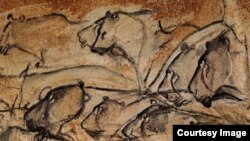The United Nations Educational, Scientific and Cultural Organization (UNESCO) on Monday announced new sites to include on its World Heritage List during its meeting in Doha, Qatar.
World Heritage Sites are determined by UNESCO to have special cultural or natural significance and meet the criteria.
A total of 26 sites were added to the list, including 21 cultural sites, four natural sites and one mixed site.
According to UNESCO, the total number of sites now on the list is 1,007. These include 779 cultural sites, 197 natural sites and 31 mixed sites.
The 1,000th site inscribed was the Okavango Delta in Botswana.
Perhaps the most well-known new addition is the Grotte Chauvet-Pont d’Arc, Ardèche, France, a cave that contains the earliest known examples of prehistoric cave art discovered.
The drawings, which are thought to be over 30,000 years old, include more than 1,000 depictions of mammoths, lions, bears, other animals and human hands.
In a statement, French Culture Minister Aurelie Filippetti called the cave “a major site for humanity,” adding that it is “a jewel whose emotional power is as strong today as when it was conceived.”
UNESCO added that the site “contains the earliest and best-preserved expressions of artistic creation of the Aurignacian people, which are also the earliest known figurative drawings in the world.”
The cave was discovered in 1994 by Jean-Marie Chauvet.
Access to the cave is extremely limited because of the delicate climate inside the caves, which has preserved the art so well.
Other sites added by UNESCO span the globe and include the Pyu Ancient Cities, the first World Heritage site in in Myanmar, also known as Burma.
The Pyu Kingdom cities of Halin, Beikthano and Sri Ksetra are located in the Ayeyarwady River basin and date from between 200 BC and 900 AD, according to UNESCO. The remains include “excavated palace citadels, burial grounds and early industrial production sites, as well as monumental brick Buddhist stupas, partly standing walls and water management features – some still in use.”
China’s Grand Canal was also added to the list. Construction of the massive water system was started in the 5th century BC, and stretches from Beijing to Zhejiang province. The Grand Canal, which served as China’s inland transport system was the “most extensive civil engineering project prior to the Industrial Revolution,” according to UNESCO.
The U.S. saw the addition of the ancient earthworks at Poverty Point, Louisiana, added to the list. The complex is made up of several mounds and ridges likely used in as living areas and for ceremonial purposes, according to UNESCO. The earthworks were built between 3,700 and 3,100 BC “by a society of hunter fisher-gatherers."
Three natural properties were also added to the World Heritage list, including Mount Hamiguitan Range Wildlife Sanctuary in the Philippines, the The Okavango delta in Botswana and the Stevns Klint geological site in Denmark.
See a complete list of the sites.
World Heritage Sites are determined by UNESCO to have special cultural or natural significance and meet the criteria.
A total of 26 sites were added to the list, including 21 cultural sites, four natural sites and one mixed site.
According to UNESCO, the total number of sites now on the list is 1,007. These include 779 cultural sites, 197 natural sites and 31 mixed sites.
The 1,000th site inscribed was the Okavango Delta in Botswana.
Perhaps the most well-known new addition is the Grotte Chauvet-Pont d’Arc, Ardèche, France, a cave that contains the earliest known examples of prehistoric cave art discovered.
The drawings, which are thought to be over 30,000 years old, include more than 1,000 depictions of mammoths, lions, bears, other animals and human hands.
In a statement, French Culture Minister Aurelie Filippetti called the cave “a major site for humanity,” adding that it is “a jewel whose emotional power is as strong today as when it was conceived.”
UNESCO added that the site “contains the earliest and best-preserved expressions of artistic creation of the Aurignacian people, which are also the earliest known figurative drawings in the world.”
The cave was discovered in 1994 by Jean-Marie Chauvet.
Access to the cave is extremely limited because of the delicate climate inside the caves, which has preserved the art so well.
Other sites added by UNESCO span the globe and include the Pyu Ancient Cities, the first World Heritage site in in Myanmar, also known as Burma.
The Pyu Kingdom cities of Halin, Beikthano and Sri Ksetra are located in the Ayeyarwady River basin and date from between 200 BC and 900 AD, according to UNESCO. The remains include “excavated palace citadels, burial grounds and early industrial production sites, as well as monumental brick Buddhist stupas, partly standing walls and water management features – some still in use.”
China’s Grand Canal was also added to the list. Construction of the massive water system was started in the 5th century BC, and stretches from Beijing to Zhejiang province. The Grand Canal, which served as China’s inland transport system was the “most extensive civil engineering project prior to the Industrial Revolution,” according to UNESCO.
The U.S. saw the addition of the ancient earthworks at Poverty Point, Louisiana, added to the list. The complex is made up of several mounds and ridges likely used in as living areas and for ceremonial purposes, according to UNESCO. The earthworks were built between 3,700 and 3,100 BC “by a society of hunter fisher-gatherers."
Three natural properties were also added to the World Heritage list, including Mount Hamiguitan Range Wildlife Sanctuary in the Philippines, the The Okavango delta in Botswana and the Stevns Klint geological site in Denmark.
See a complete list of the sites.







